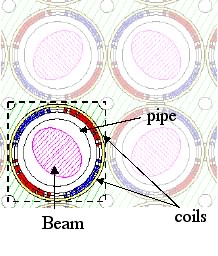High-Current Experiment
The High-Current Experiment, called HCX, is the first transport experiment using a driver-scale heavy-ion beam. The project is designed to address important science questions involving the optimum beam size and the preservation of good beam quality during transport. Five principal issues will be addressed:
- Measuring the allowable "fill factor" (ratio of maximum beam radial extent to aperture radius) for transport of space-charge-dominated heavy-ion beams and understanding what physical phenomena limit this ratio.
- Investigating how the maximum transportable current is affected by misalignments, beam manipulations, and field nonlinearities.
- Determining the radial extent of beam halo resulting from mismatch and other errors.
- Studying the effects of unbound electron generated by halo scrape-off and by ionization of the residual gas.
- Improving techniques for measuring the phase-space distribution of a beam.

The HCX began operation in January 2002 with a beam of singly charged potassium ions drifting through a six-quadrupole matching section and ten electrostatic transport quadrupoles [1]. Electrostatic focusing is used for the first experiments because it provides the most efficient transport at low energy and helps sweep out unwanted electrons. The HCX beam, obtained from the LBNL 2-MeV Injector, has been successfully matched to the transport quadrupoles and has a line-charge density (0.1-0.2 µC/m), an injection energy (1-1.6 MeV), and a duration (4 µs) that are near values of interest for fusion drivers. The experiment is now addressing scale-dependent issues, such as halo formation and electron dynamics, that did not affect previous low-current experiments. The present experimental layout can be seen in a movie showing a numerical simulation of HCX.
The present HCX lattice with ten transport quadrupoles is the correct length for studying the rapid evolution of the emittance and the beam profile just following injection. However, the experiment is too short for addressing questions of long-term emittance evolution in a quadrupole transport lattice. We hope to add twenty to thirty more quadrupoles to increase the transport length to 4.5-6 plasma periods. Theoretical models predict that this length would be just enough to observe the relaxation of phase space inhomogeneities, allowing an optimum choice of the current and bore diameter.
Magnetic transport experiments have begun on HCX to gain operational experience and to explore transport-limiting effects not found in electrostatic focusing systems, particularly electron trapping in the ion-beam potential well.
For comments or questions contact WMSharp@lbl.gov or DPGrote@lbl.gov. Work described here was supported by the Office of Fusion Energy at the US Department of Energy under contracts DE-AC03-76SF00098 and W-7405-ENG-48. This document was last revised August, 2003.
